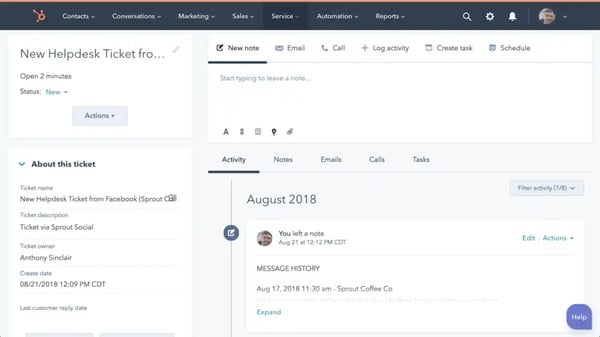As marketers, we understand the importance of incorporating social media into our marketing mix. In fact, 74% of global marketers continue to invest in social media marketing.
If you haven’t yet considered expanding your existing social media strategy, you may be missing out on valuable channels for advertising. In this post, we’ll give brief explanations of the importance of social media for business, as well as outline eight ways that marketers can leverage social media to meet business goals.
Why is social media important for business?
If you’re new to social media in general, there are social media certification courses you can take to learn a bit more about attracting and building brand loyalty. These courses will guide you through the process of building an effective social media marketing strategy that you’ll use to leverage the power of social media to transform your business.
Due to the sheer amount of users (3.81 billion to be exact), sharing business-related content on your preferred platforms will likely expose you to new customers. A direct result of increased brand awareness is driving leads, and 37% of consumers name social media as the most significant source of inspiration for their purchases. This even goes for brick-and-mortar business like restaurants, where 42% of respondents prefer social media to search engines (Google, Yelp, etc.) when trying to discover new restaurants and places to eat.
Also, using social media helps you grow and nurture your relationships with customers. Instead of merely being a name on their receipts, being active on different platforms allows you to engage with them beyond their purchases to show them that you genuinely care about their business.
Considering these factors, let’s go over eight ways that marketers can leverage social media to meet their business objectives.
8
- Learn About Your Personas
- Promote Content Through Diverse Channels
- Keep Engagement High
- Provide Customer Support
- Influencer Marketing
- Nurture Leads
- Sales Prospecting
- Show a New Side of Your Business
1. Learn About Your Personas
If your overall business goal is to learn more about your target markets or buyer personas, using different social media sites can help you do this. Every site has a different demographic user base, so you’ll interact with diverse audiences and gain well-rounded insights into every audience group you have and how to best market to them.
For example, 32.5% of TikTok’s user base is between 10 and 19, whereas 33.1% of global Instagram audiences are between 25 and 34 years old. If you’re a clothing business, you likely sell and create clothing for various age groups. Suppose you devise a marketing strategy for both platforms. In that case, you’ll gain valuable insight into how each of these demographic groups likes to be marketed to, engaged with, and what drives the most conversions.
You can use social media analytics, which is quantifiable data that provides insight into your followers’ behavior and how they engage with your content. You’ll understand what type of content each audience group likes and what drives the most conversions. Learning more about your customers and what they want makes it easier to create targeted advertisements that appeal to your existing customers and attract new ones.
2. Promote Content Through Diverse Channels
If your business’s sole online presence is your website, you may be missing out on valuable promotional opportunities that can come from social media sites. While websites are great for promotional blog posts, social media can accommodate those in addition to videos, images, and other forms of unique, high-quality content. The value of social media advertising is clear, as 58% of marketers say that social media has helped them boost sales.
If you choose to go this route, there are multiple high-performing sites where you can promote content to delight existing customers and draw in new ones. For example, Facebook ads can be shown to users who haven’t yet liked your page or ever interacted with your content.
However, it’s important to note that the social media sites you choose to use to promote your content should be relevant to your business’ overall strategy. If you cater to an older audience, deciding to use TikTok wouldn’t make much sense since the audience is significantly younger than other platforms. In contrast, if your goal is to diversify your social media channels and target new audiences, a business with an older user base would benefit from using TikTok to drive new leads through promotional content.
In a nutshell, venturing into social media advertising allows you to promote your content through as many social channels as you like. You’re not limited to targeting a specific audience as you are through, say, email marketing because social media advertisements can reach people you’ve yet to have contact with or even identify as leads.
3. Keep Engagement High
While there are various ways to keep your business’ engagement high, social media is a great channel to do so, as these sites have incredibly active user bases. Here are some stats to consider:
- During the third quarter of 2020, Facebook reported almost 1.82 billion daily active users.
- The number of global monetizable daily active users (mDAU) on Twitter is 187 million users.
- LinkedIn has 675 million monthly active users worldwide.
- TikTok’s average engagement rate is significantly high at all follower levels, with smaller accounts holding 1,000 followers having an average engagement rate of 9.38%.
- On average, users spend 144 minutes a day on social media.
These statistics show us that there is potential for high engagement across all social media sites. Considering that these stats account for global users, time zone distribution means that there will always be someone online, and there will always be someone ready to interact with your tweets, Instagram Stories, and Facebook posts.
When you’re active across your social media sites and carefully follow a marketing strategy that considers your followers interests, your engagement rates will remain high no matter what platforms you choose to use.
4. Provide Customer Support
50% of customers purchase more from companies that they believe provide outstanding customer service. 59% of global social media users also have a more favorable view of brands that respond to customer service questions on social media. Given this, the benefits of leveraging social media as a means of providing excellent customer service are significant in terms of meeting customer expectations.
You can offer customer support on social media channels in various ways, like responding to customer complaints on Twitter or chatting with them on Facebook Messenger. Here’s an example from HelloFresh, a meal delivery subscription service, using Twitter as a means of customer support.
Please reach out to our customer care team at 646-846-3663 or email us at hello@hellofresh.com so we can further assist you.
— HelloFresh US (@HelloFresh) November 16, 2020
In addition to responding to questions, you can use your social accounts to share helpful links to customer issue solutions. The recent customer service pivot to crisis management customer service has shown many businesses that customers value being made aware of issues ahead of time without discovering them on their own. They appreciate transparency, and social media is a great way to make this information public.
In practice, this could look like alerting customers ahead of time of possible shipping delays through a tweet on Twitter or posting an Instagram Story letting restaurant visitors know that you’ve closed your restaurant early due to unforeseen circumstances.
To ensure that you’re consistently providing excellent customer service, social media management tools like Sprout Social can make your job easier. The service has a social media customer care function, where marketers can track customer support requests across all social media sites. Sprout Social integrates with HubSpot Service Hub, where you can communicate with service reps and seamlessly pass off customer service tickets as they come in. The image below depicts a Service Hub helpdesk ticket that originated on Facebook.

5. Influencer Marketing
71% of marketers say that the quality of customers and traffic generated from influencer marketing is better than other ad formats. Every one dollar spent on influencers has a return on investment (ROI) of $5.78.
In short, influencer marketing is when a business partner with an influencer, or someone who is generally looked up to and trusted by their followers, to put out an advertisement or piece of content. The aim of these partnerships is for each party to attract new customers from the other user-base and entice followers to take a specific action like purchasing a product or service.
While influencer marketing is common on websites through guest bloggers, leveraging social media to venture into the world of influencer marketing is profitable, especially on Instagram. Here’s an example of influencer marketing on Instagram featuring music artist Amine, where he’s advertising a collaboration with a basketball team.
Although Amine is a celebrity, influencer marketing can be done with micro-influencers, social media influencers, and opinion leaders, so long as their interests are aligned with your brand.
For example, say you’re a beauty company. You’d want to partner with an influencer known within that community, like a skincare expert or a lifestyle blogger. The relationship is contextually relevant, and the users they’d bring to your profile will likely be interested in what you have to offer.
6. Nurture Leads
Email is what most marketers think of when it comes to lead nurturing, but it’s not the only medium for doing so. Considering that 96% of site visitors are qualified by not yet ready to buy, social media marketing can significantly benefit your efforts to nurture new leads.
On your social media sites, you can provide a mix of content that addresses customers at various levels of the buyer's journey, which is the process that consumers go through before making a final decision to follow through with a purchase and become a customer.
You can create educational content like short social media posts for top-of-the-funnel customers in the awareness stage and bottom-of-the-funnel content for users in the purchasing stage like Instagram videos of product demos.
7. Sales Prospecting
After leads have been identified, you can work with sales representatives on social media to identify prospects from those leads and attempt to convert them into paying customers.
You can teach sales representatives to use social media intelligence tools for this process, where they can conduct social listening. Social listening is the process of monitoring your business’ social media channels for direct and indirect mentions of your brand through relevant keywords. By doing this, they can collect information that describes how prospects interact with your social media accounts.
Oktopost, a social media management tool, can be used to carry out sales prospecting on social media. You can track how prospects have engaged with your brand on social media and leverage the data to create individually tailored marketing strategies. Oktopost can integrate with the HubSpot CMS, and the image below depicts a sales email-nurturing workflow specifically tailored for an interested prospect. 
8. Show a New Side of Your Business
If you’re looking for different ways to connect with your audience, leverage social media to show an authentic side of your business and post behind-the-scenes content.
Behind the scenes content humanizes your company to your audience, as you’re showing them the life cycle behind the product or service that your business sells. It can showcase your brand's unique personality and give users an idea of who the employees are that create the products they love.
Customers enjoy this type of content, especially on TikTok. The platform is primarily used by Generation Z, who care more about authenticity in advertisements than the traditional sales to drive leads model. If your brand or business typically creates sales-driven formal content, utilizing the platform can help you diversify your content type and display a new, creative side of your business and attract a new user base.
Vintage Stock Reserve, a small fashion brand, capitalizes on TikTok’s interest in behind-the-scenes content and often posts videos depicting the process of how they make their clothing. Sometimes they take requests, and they post videos of the process of designing custom clothing items. Their first video received 39.3K views, and their most popular video now holds 26M + views. The video below is an example of their behind-the-scenes content.
@vintagestockreserve Wow!!! Thank you so much🙌 We love Australia🇦🇺 to @adriangrujic
♬ Memories - Brandon Kai
All in all, there’s nothing wrong with the regular sales to drive leads style content, and marketers know that it works. However, as Generation Z grows up and can make purchases independently, learning how to create content that satisfies them and entices them to make purchases can position your business for success.
Leveraging social media can be valuable to your business.
Whether you’re hoping to expand your customer support channels or make use of influencer marketing, there are various ways to leverage social media to meet your overall business goals.
If you take the time to create platform-specific marketing strategies, your business will likely reap the benefits of using social media.

Social Media Strategy


![→ Free Download: Social Media Calendar Template [Access Now]](https://no-cache.hubspot.com/cta/default/53/3e56e15d-47bd-46c9-a256-99fde52abfe7.png)
![The most effective types of content on social media in 2025 [new data]](https://53.fs1.hubspotusercontent-na1.net/hubfs/53/Copy%20of%20Featured%20Image%20Template%20Backgrounds%20(16).png)


-1.jpg)
.png)
![How to Create a Great Social Media Strategy in 2025 [+ New Data]](https://53.fs1.hubspotusercontent-na1.net/hubfs/53/social-media-strategy.webp)



